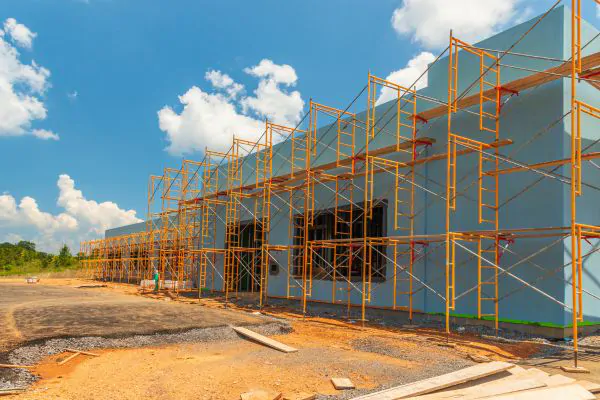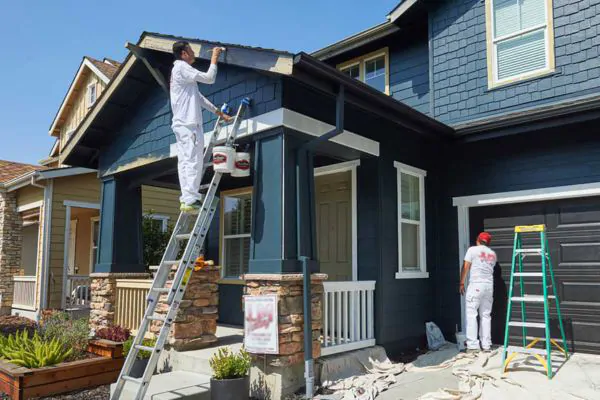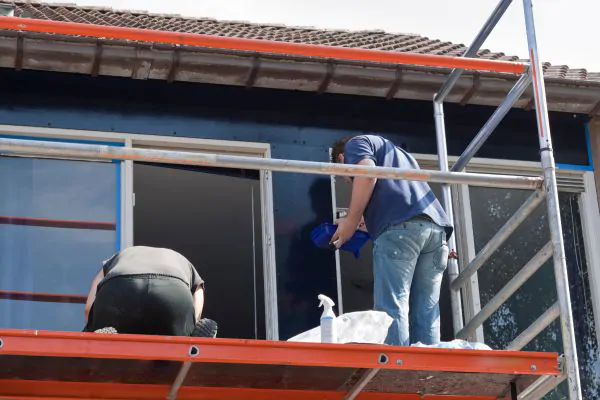Painting is more than applying color to walls; it’s about giving life and personality to a space.
Whether it is a cozy home or a sprawling commercial property, painting plays a vital role in transforming and enhancing any area.
But have you ever wondered what sets residential painting apart from commercial painting? Painting is painting right? How different can they be?
Understanding the differences in these services can help you make better decisions for your next project.
Keep reading to explore the unique aspects of residential and commercial painting.
What is Commercial Painting?
Commercial painting involves projects for businesses, schools, and other large-scale properties. Unlike residential painting services, it often requires specialized skills and tools to handle bigger areas and complex surfaces. Commercial painters usually work on structures like offices, stores, and warehouses.

One key aspect of commercial painting is its focus on durability and protection. These properties often experience high traffic, so the paint used must withstand wear and tear from various environmental factors and normal wear and tear during facility use. This protection includes using coatings that resist stains, water damage, mold, and other potential issues.
The process of commercial painting typically involves comprehensive planning and coordination. Painters might need to work around the business’s operating hours to minimize disruptions. This requires strong project management skills to ensure everything is completed on time and within budget.
What is Residential Painting?
Residential painting involves painting homes, including rooms like the kitchen, bedroom, and bathroom. This type of painting focuses on making a house look appealing and protecting surfaces like walls, ceilings, and wood from damage. It also focuses on more creative use of color and design elements that usually don’t exist with commercial painting services.
Homeowners often hire residential painters to improve the interior or exterior of their property. A house painter and decorator may work on painting walls, installing drywall, waterproofing, and even repairing water damage. They will also be a key player in redesign and renovations that involve painting and room refinishing.

Residential painting can also include tasks such as cabinet painting, adding accents to a dining room, and applying a fresh coat to furniture. Homeowners value the appearance and longevity of the paint job. This makes it important for professionals to use high-quality materials and techniques.
Commercial Painting vs Residential Painting

Key differences lie in the materials and equipment used, the scope of the job, the experience and expertise required, and the number of workers involved. These distinctions impact everything from the planning stage to the final execution, ensuring that each type of project meets its unique demands and requirements.
Materials and Equipment
Commercial painting contractors often use heavy-duty materials and specialized equipment to deal with large areas and varied surfaces. Tools like high-pressure sprayers and industrial-grade paint ensure durability, especially for spaces with high foot traffic like schools and stores.
On the other hand, residential painting involves more detailed and delicate work suited for home interiors and exteriors. Residential painters frequently use brushes and rollers for a smooth finish and may employ smaller tools for precision tasks like trim and cabinet painting. The focus here is on achieving an appealing and long-lasting look for spaces like bedrooms, kitchens, and bathrooms.
Job Scope
Commercial painting projects usually involve large-scale tasks like painting offices, warehouses, and schools. These jobs often require managing multiple workers and coordinating with other trades to complete the project efficiently without disrupting business operations.
In contrast, residential painting focuses on individual homes and smaller spaces such as bedrooms, kitchens, and bathrooms. Residential painters often work closely with homeowners to choose colors and finishes that match the interior design and provide a personalized touch to living spaces.
Experience and Expertise Required
Commercial painting often demands a higher level of expertise due to the scale and complexity of the projects. Painters need to be experienced in using specialized equipment like high-pressure sprayers and scaffolding to ensure safety and efficiency. They must also understand how to handle various surfaces and materials such as concrete, metal, stucco, and brick.
Residential painting focuses more on attention to detail and customization. Experienced residential painters know how to work efficiently in smaller spaces like bedrooms, kitchens, and bathrooms. They also have a keen eye for interior design, helping homeowners choose colors and finishes that enhance the beauty and value of their homes.
Man Power
Commercial painting projects usually require a larger team of painters due to the scale of the work involved. Many commercial properties, like warehouses and office buildings, are vast and require multiple workers to complete the job efficiently within tight deadlines.
In contrast, residential painting projects often need fewer workers, as homes are generally smaller. A smaller team or even a single painter might be sufficient to complete tasks such as painting a bedroom, kitchen, or bathroom, allowing for more personalized attention to detail.
Here’s a good guide about how to estimate the amount of labor required for the job.
Is commercial painting more expensive than residential?
When comparing the costs of painting residential and commercial properties, several factors come into play. Labor costs can vary significantly due to the number of workers and time required. The type of paint and materials needed can differ based on durability and the specific needs of the project. Overall scope and size of the project also contributes to the cost, with larger commercial areas typically costing more than residential spaces.
Additionally, commercial projects may need extra services such as pressure washing or industrial-grade coatings, while residential projects might require decorative touches or minor repairs. Understanding these factors helps clarify why painting a commercial property is often more expensive than residential painting. While it is hard to give a yes or no simple answer to this question it is easier to see cost breakdowns when you compare what services you will get with commercial painting or residential painting.
Labor Cost
Labor costs for commercial painting projects tend to be higher due to the need for larger teams and specialized skills. These projects often require multiple workers to efficiently tackle extensive areas such as warehouses or office buildings, leading to increased labor expenses.
Residential painting, on the other hand, usually involves smaller teams or even individual painters. Since the scope of work is limited to homes and smaller spaces like bedrooms or bathrooms, the labor costs are generally lower compared to commercial painting projects.
You might like: Exterior Painting Costs | What You Need to Know
Type of Paint Required
In commercial painting, the type of paint required often has to be more durable and resistant to wear and tear. Commercial environments like offices or stores experience high traffic, necessitating the use of industrial-grade paints that resist stains, moisture, and other damages.
Painting contractors for residential properties focus more on aesthetics and comfort, so the paints used are usually designed to provide a beautiful finish and easy clean-up. In homes, specific areas such as bathrooms and kitchens might require special paints to handle moisture and frequent cleaning, but overall, the emphasis is on achieving a pleasing interior design.
Size of the Project
The size of the project significantly impacts the cost difference between commercial and residential painting. Commercial projects usually cover larger areas such as office buildings and warehouses, requiring more materials, labor, and time, which can increase overall costs.
In contrast, residential painting projects typically involve smaller spaces like individual homes, bedrooms, or kitchens. This limited scope requires fewer materials and less labor, making the overall cost relatively lower compared to commercial painting.
Additional Services Need for Commercial
Commercial painting projects often require additional services to prepare surfaces for painting such as pressure washing, waterproofing, and sandblasting.
Other essential services may include:
- Concrete ceiling repair,
- High-durability coatings,
- Line striping,
- Light cleaning and prep,
- Masonry coating,
- Roof coatings
- Metal door painting,
- Scaffolding,
- Equipment and tool provision,
- Joint expansion sealing,
- Waterproof coatings
- Post clean up services
These services ensure that the paint adheres properly and lasts longer, especially in high-traffic and industrial areas. The tools, services, and added features professional painters provide help ensure every project delivers and goes above expectations. These extra steps and materials can increase the overall cost and complexity of the project compared to residential painting.
Related Post: How to Choose the Best Home Painting Company in Your Area
Additional Services Needed for Residential
Residential painting often involves additional services to enhance the appearance and functionality of the home. Homeowners might request wall repairs, such as fixing drywall or plaster before the painting begins. These repairs ensure a smooth and even surface for the paint to adhere to.

Other common additional services include waterproofing areas prone to moisture and adding decorative elements like crown molding or baseboards. These tasks require detailed attention and can increase the overall cost and time needed to complete a residential project.
Here are additional services commonly done for a residential project:
● Cabinet painting and refinishing,
● Drywall repair services,
● Ceiling paintings options,
● Basic cleaning before and after,
● Vinyl and aluminum siding painting,
● Interior and exterior home paining services,
● Deck and fence staining/painting
Talk to a Painting Contractor Today!

Don’t hesitate to reach out if you have any questions or need a quote. Give us a call or send us a message—our friendly and knowledgeable staff are ready to assist you and make your home improvement project a success. Choose Quality Preferred Painting and experience the difference quality makes!
Conclusion
Understanding the differences between residential and commercial painting is essential for choosing the right contractor and ensuring project success.
Residential painting focuses on enhancing the beauty and functionality of homes, while commercial painting deals with larger properties requiring specialized materials and equipment.
Knowing these distinctions helps in planning the scope, budget, and necessary services for each type of project.
Consulting a professional painting contractor ensures high-quality results tailored to specific needs. Don’t put off that residential or commercial painting project any longer! Get help from the local painting experts and make the call today!








